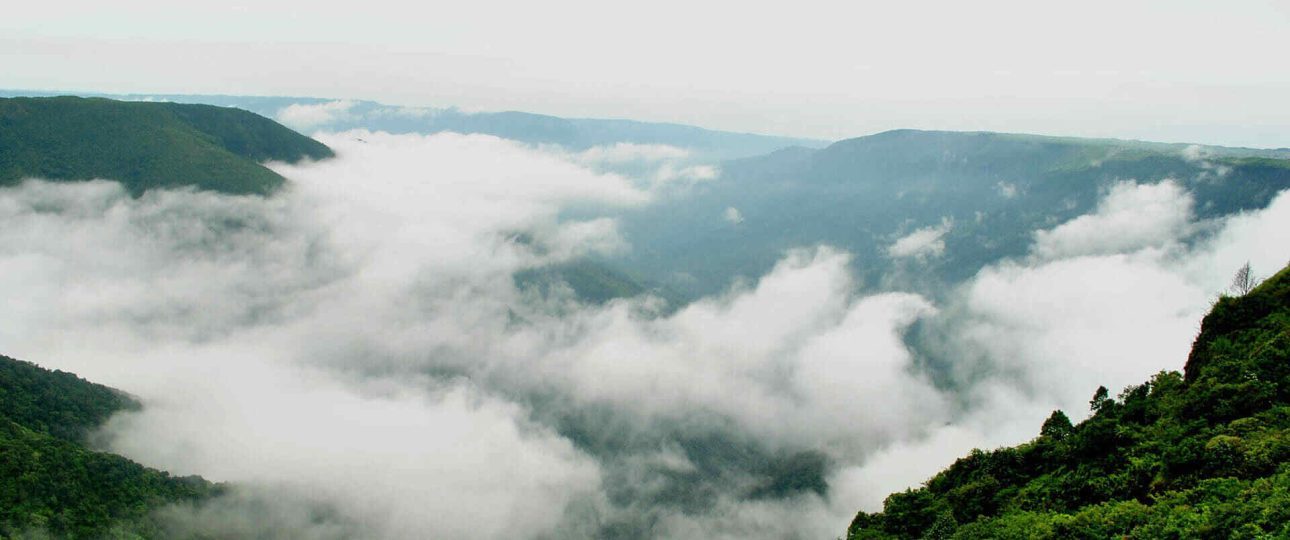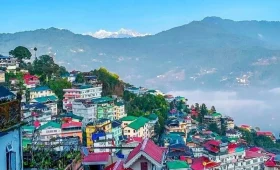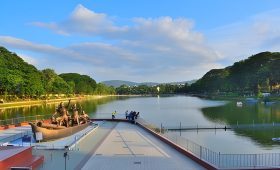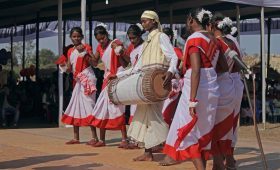A place where the clouds come alive during the monsoon season. Meghalaya, aptly called the “Abode of Clouds,” transforms into a breathtaking paradise every monsoon, thus carrying the tag of crazy monsoon in Meghalaya. Dense greenery blasts forth, breathing life into the landscape with a magical charm. Waterfalls come alive, creating a symphony of sound.
The monsoon in Meghalaya, spanning from June to September, is a sight to behold. It’s not just the visual splendor that enchants visitors; the vibrant culture of the state comes alive during this time. Locals celebrate with a multitude of festivals, showcasing their rich heritage through music, dance, and traditional attire.
While the monsoon might prevent some adventure seekers, it’s a season that holds a unique charm for those who love nature’s raw beauty. You can imagine experiencing the majesty of cascading waterfalls at their peak or the serenity of Umiam Lake surrounded in mist. The monsoon paints a picture of Meghalaya that’s both breathtaking and mystical, making it a time to visit Meghalaya that you won’t forget.
Why choose Meghalaya for Monsoon Vacation?
If there is one spot in India that truly celebrates the magic of the rainy season, it has to be Meghalaya. While many people think the monsoon is not the right time to travel, Meghalaya turns into a beautiful peace-land in this time. The clouds come down low, the hills turn bright green and the waterfall flows in full force. Here it feels like nature is dancing in joy.
Here is why we think you must think about visiting Meghalaya during the monsoons:
Waterfalls at Their Best
Meghalaya is known for its beautiful waterfalls—and the rains make them even more powerful and mesmerizing. During the monsoon, these waterfalls come to life with a thunderous roar and misty spray. Whether it’s Nohkalikai, Seven Sisters, or Elephant Falls, you’ll find them in their most magical form—surrounded by lush greenery and cool mountain air. It’s a perfect sight for nature lovers and photographers!
Living Root Bridges & Green Forests
One of Meghalaya’s most special wonders is its living root bridges, especially the famous double-decker one in Nongriat. These bridges are made from the roots of trees and look even more beautiful when surrounded by the fresh, green forests after rain. The entire landscape looks like something out of a fairytale—peaceful, fresh, and glowing with life.
Clouds, Mist & Hills
If you’ve ever wanted to walk through clouds, Meghalaya is the place! Places like Cherrapunji (Sohra) and Mawsynram—two of the wettest places on Earth—are covered in mist during the rains. The rolling hills disappear into the clouds, making the view feel dreamlike. Laitlum Canyon and Shillong Peak become picture-perfect spots as well, giving you a feeling of floating in the sky.
Beautiful Drives & Hidden Villages
A road trip in Meghalaya during the monsoon is an experience in itself. The drive from Shillong to Cherrapunji is full of surprises—think waterfalls flowing down the cliffs right beside the road! You can also visit peaceful places like Mawlynnong, known as Asia’s cleanest village, and Dawki, where the Umngot River looks even more magical with its crystal-clear water during the rains. You might even spot the riverbed from a boat
Tourist Places to Visit during the Monsoon in Meghalaya season
Cherrapunji (Sohra) – The Rain Capital
If you enjoy the soothing sound of rain and the powerful rush of waterfalls, then Cherrapunji is the perfect place for you. Especially during the monsoon in Meghalaya feels like a piece of paradise. The cliffs turn a rich green, clouds float low over the hills, and the waterfalls become louder and more beautiful than ever. It’s also home to hidden caves, living root bridges, and postcard-worthy views you’ll want to remember forever.
Cherrapunji has something for all; whether you’re an adventure lover or someone who simply enjoys the beauty of nature, Cherrapunji will leave you in awe, especially when it’s raining!
Here are some of the must-visit places in Cherrapunji that turn magical during the monsoon season:
Nohkalikai Falls – This is India’s tallest plunge waterfall, and during monsoon, it crashes down the cliffs with incredible force. Surrounded by mist and greenery, it’s truly a sight you won’t forget. A must experience during monsoon in meghalaya.
Seven Sisters Falls – A gorgeous waterfall with seven separate streams flowing side by side. It looks best from the Eco Park viewpoint, especially after a good rain.
Mawsmai Cave – These natural limestone caves are full of twists, turns, and little water streams during the rains. It’s like walking through nature’s own tunnel.
Dainthlen Falls – A wide, peaceful waterfall with a story. According to Khasi legend, this is where a giant serpent was defeated. The surroundings are open and scenic—perfect for a short, relaxing visit.
Mawsynram – Wettest place on earth
This quiet little village has a global title—it’s officially the wettest place on Earth! But don’t imagine wild storms and chaos. Instead, the monsoon here feels peaceful, soft, and almost magical.
During the rainy season, the village is wrapped in clouds, the hills turn bright green, and everything feels calm and dreamy. It’s the perfect place if you enjoy slow travel—walking at your own pace, soaking in the fresh air, and simply being with nature.
Here are a few beautiful places to explore in Mawsynram during the monsoon:
Mawjymbuin Cave – A sacred and naturally beautiful cave, known for its naturally formed Shiva lingam and slowly dripping stalactites. It’s a peaceful place to visit, especially when the rain adds to the atmosphere.
Living Root Bridges – While Nongriat has the famous double-decker bridge, Mawsynram has its own smaller, less-crowded root bridges like the one at Riwai. Perfect for those who want a quieter, more relaxed experience.
Cloud-Covered Hills – The views here are surreal. Rolling green hills covered in soft mist make it feel like you’re walking through a dream. It’s a paradise for photographers and anyone who loves scenic landscape.
Nongriat Village – Double Decker Root Bridge
Nongriat is just the place if you are looking for true adventure. It’s not your usual tourist spot and you’ll have to trek down nearly 3,000 steps from the village of Tyrna to reach it. But trust us, the journey is part of the magic, and the reward is totally worth it.
At the heart of Nongriat lies the famous double-decker living root bridge—a one-of-a-kind structure made from the roots of ancient trees, woven over decades by the local Khasi people. It’s a perfect mix of nature’s beauty and human creativity.
During the monsoon in Meghalaya, the experience becomes even more special. The whole trail is filled with the sound of flowing water, chirping birds, and the smell of wet earth. Rain-fed streams, thick green forests, and misty air turn the walk into something straight out of a storybook.
Here’s what you can enjoy in Nongriat during the rains:
Trek through green, rain-soaked forests – The hike might be a bit challenging, but walking through the misty, green trails makes it feel like an adventure in a hidden jungle. A famous and must to do thing if you are coming during monsoon in Meghalaya
Natural Pools – Close to the root bridge, you’ll find cool, jade-green natural pools where you can dip your feet or take a refreshing swim. It’s the perfect way to relax after the long trek.
Rainbow Falls – If you’re feeling extra adventurous, trek another 3 hours beyond the village to reach Rainbow Falls. It’s a hidden gem, surrounded by thick forest and often graced by a rainbow forming in its mist—pure magic for nature lover.
Dawki and Umngot River
Even with the rains, Dawki’s Umngot River manages to keep its magic. The water often stays so clear that the boats look like they are floating on air. It’s no surprise this river is one of the most photographed in India, it’s surreal beauty can keep you mesmerized.
During the monsoon in Meghalaya, the surrounding hills are covered and wrapped in mist and fog that adds a soft dreamy charm to the whole place. If you love peaceful scenery and calm village vibes, Dawki is the perfect stop.
Here are a few things you shouldn’t miss in Dawki during the monsoon in Meghalaya.
Crystal Clear Boat Rides– Even with some rain, the Umngot River often stays a surreal shade of green. A boat ride here feels like gliding over glass- totally magical.
Shnongpdeng Adventure– Just a little upstream from Dawki, Shnongpdeng offers fun activities like cliff jumping and kayaking. If the weather is safe, it’s great place for adventure lovers.
Mawlyngbna – Where Nature and Adventure Meet
Mawlyngbna is a quiet village in Meghalaya that’s perfect for people who love nature, peace, and a bit of adventure. You can truly visit this spot as its very appropriate for activities that indulge water and a bit of trekking.
Standing as the must to do spot here during the monsoon in Meghalaya, Mawlynbna has three main and very famous activities that range from the river trek, a split rock trek and river canyoning. You can take a day or two to explore the activities here. Everything is fine and simple with the help of the friendly and experienced guides. A total must do during the monsoon in Meghalaya.
Weinia Falls – A Hidden Gem of Meghalaya
Weinia Falls is one of the most powerful and lesser-known waterfalls in Meghalaya, located near Nongkhnum Island in the West Khasi Hills. During the monsoon season, this waterfall is at its grandest. Water comes rushing down high cliffs and falls into a deep rocky gorge, creating a loud, thunder-like sound that echoes through the hills. Surrounded by lush greenery and dramatic landscapes, Weinia is perfect for nature lovers and anyone who wants to enjoy a peaceful escape.
The mist from the falls and the cool breeze add a magical feel to the experience. Since it’s still not as popular as other waterfalls, you’ll find fewer tourists and more quiet time to enjoy the view. You can relax, take photos, or simply sit and enjoy the sound of nature. If you’re exploring Meghalaya in the monsoon, Weinia Falls should definitely be on your travel list.
Mawphanlur – A Scenic Retreat in the Hills
Mawphanlur is a small, picturesque village in the West Khasi Hills of Meghalaya that feels like a peaceful painting come to life. It’s known for its rolling green hills, tiny sparkling lakes, and cool mountain air. During the monsoon, this village turns extra beautiful, with mist covering the hills and raindrops gently falling on the lakes. It’s a perfect place to unwind, especially if you enjoy slow travel and nature. You can take long walks, sit by the lakes, and watch the clouds move across the sky.
Mawphanlur in Meghalaya in monsoon also offers cozy cottages where you can stay and wake up to beautiful views. Since it’s not a crowded place, you’ll enjoy peace and quiet away from city noise. It’s also great for stargazing at night when the sky clears. If you’re looking for a calm, refreshing place to recharge and reconnect with nature, Mawphanlur is the perfect monsoon destination.
Mawsynram – The Rain Lover’s Paradise
Mawsynram is known across the world as the wettest place on Earth—and visiting it during the monsoon is a magical experience. While it rains a lot, the showers are often soft and calming, not stormy. The hills here are covered in thick clouds, and the lush green landscapes look like something out of a dream. Everywhere you go, you’ll hear the sound of water—rivers, waterfalls, and raindrops on leaves. One of the highlights is Mawjymbuin Cave, which has a natural rock formation that looks like a Shiva lingam. The cave has cool dripping stalactites and feels peaceful inside.
You can also walk through nearby forests and discover hidden root bridges. Mawsynram is quiet, peaceful, and ideal for slow travel. If you love misty weather, green hills, and the gentle rhythm of rain, you’ll fall in love with this place. It’s truly a monsoon wonder that soothes your soul.
Monsoon and Cultural Practices
Agricultural Rituals
The monsoon season in Meghalaya is a time of celebration and agricultural activity. The lifeblood of the state’s agriculture, the monsoon rains are crucial for a bountiful harvest. This deep connection between nature and farming is reflected in the vibrant festivals and rituals that come alive during this time.
As the monsoon arrives, farmers in Meghalaya gear up for planting rice, their main crop, along with other seasonal favorites. This is a communal affair, often accompanied by prayers and offerings to deities like those for rain and fertility. These rituals pay homage to nature’s bounty and express hope for a successful harvest season ahead. The success of the monsoon literally sets the tone for the festivals and celebrations that follow, making it an integral part of Meghalaya’s cultural tapestry.
Rain and Spirituality
The monsoon rains in Meghalaya hold a deep spiritual significance for the Khasi, Jaintia, and Garo tribes. These heavy downpours are seen as a life-giving blessing from the gods, bringing not just bountiful harvests but also spiritual renewal.
Khasi Tribe: The Khasis believe the god Lei U Blei, the sky god, brings the rains. Legends speak of a time when humanity angered Lei U Blei, leading to a great drought. The story goes that a kind woman named Um Dieng Sohphoh climbed the sacred peak Shillong Peak to appease the god with offerings. Lei U Blei, touched by her sincerity, sent down the life-giving rains once more.
Jaintia Tribe: The Jaintias have their own creation myth tied to the monsoon. They believe that the first thunderstorm marked the separation of heaven and earth. The heavy rains are seen as a time of renewal, washing away the sins of the past and ushering in a period of prosperity.
Garo Tribe: The Garos associate the monsoon with fertility and the abundance of nature. Their creation story tells of a celestial being who descended to earth, bringing with him the first rains. These rains not only nourished the land but also gave rise to life itself.
Accommodation and Transportation:
Here’s a continuation of the previous response focused on accommodation and transportation during the monsoon season in Meghalaya:
Accommodation
Shillong: As the capital city, Shillong offers a wider range of options, from budget-friendly guesthouses to comfortable hotels. During festivals, booking in advance is recommended, especially for homestays that provide a more immersive experience. Hotels such Arbour inn, M Crown, Hotel Polo Tower, Pine Hill Homestay.
Festival Locations: Monsoon in Meghalaya can also be famous for the various festivals that come alog the way. While the festivals themselves are held in specific villages like Smit (Nongkrem) or Jowai (Behdienkhlam), staying in nearby towns like Shillong or Cherrapunjee is a good option. These towns offer easier access to public transport and a wider variety of accommodations. Homestays in these villages can also be an option if you prefer a more local experience.
Transportation
Getting to Meghalaya: Pack your patience, please. Landslides are common during the monsoon, so be prepared for potential delays if traveling by road. Shillong has the Umroi Airport, connected to major cities in India.
Getting Around: Public transportation within Shillong is reliable, with taxis and buses readily available. However, reaching the festival locations might require hiring a car for the day. This is a convenient option, especially if you’re traveling with a group. Negotiate fares beforehand, and ensure the car is in good condition for monsoon travel.
Monsoon Travel Tip: Roads can get slippery during the monsoon. Opt for taxis or drivers familiar with the local routes, especially if you’re not comfortable driving in the rain.
Travel Tips:
Meghalaya during the monsoon is a dream—but like any adventure, it comes with its own set of challenges. From slippery trails to sudden roadblocks, being prepared can make your trip not only safe but also much more enjoyable. So, if you’re planning to explore this beautiful rain-soaked land, here are some essential travel tips to keep in mind:
Pack Smart – Waterproof Everything!
- Rain Gear: Don’t forget a good-quality raincoat or poncho, a strong umbrella, and a waterproof backpack to keep your things dry.
- Footwear: A pair of sturdy waterproof trekking shoes with good grip is a must, especially if you’re visiting root bridges or going on forest treks.
- Quick-Dry Clothing: Carry light clothes that dry fast—you’ll likely get wet!
- Protect Your Gadgets: Use zip-lock bags or dry pouches to keep your phone, power bank, camera and camera set safe from rain.
Plan Your Transport Carefully
- Road Conditions Can Change Fast: Landslides are common in hilly areas like the Shillong–Cherrapunji route during heavy rains. Always check weather and road updates before starting your journey.
- Hire Local Drivers: They know the roads and monsoon conditions well. If you’re not used to driving in the hills, it’s better to avoid self-driving.
- Flight Delays Are Possible: Flights to Shillong or Guwahati can get delayed due to bad weather. It’s smart to keep 1–2 buffer days in your plan just in case.
Safety First
- Don’t Trek Alone in the Rain: Trails like Nongriat and Rainbow Falls can be slippery. Always go with a local guide who knows the route.
- Leech Alert!: Leeches are common during the monsoon in forests. Use salt or Dettol to keep them away, and consider wearing leech socks.
- Stay Weather-Aware: Follow Meghalaya Tourism on social media or tune into local news to stay updated on weather alerts or roadblocks.
Food & Health Tips
- Taste Local Monsoon Favorites: Warm up with hot ginger tea, jadoh (a traditional Khasi rice and meat dish), or smoky pork curry—perfect for rainy evenings.
- Drink Safe Water: Stick to bottled or boiled water to avoid stomach problems.
- Carry Basic Medicines: Roads can be bumpy and wet, so keep tablets for motion sickness, fever, cold, and stomach issues handy.
Is it worth visiting Meghalaya in Monsoon?
Yes, Meghalaya in the monsoon is absolutely worth visiting. The hills come alive with greenery, the waterfalls are at their fullest, and the clouds often float right beside you. If you love nature, the monsoon adds a magical touch to every corner of Meghalaya.
What are the best places to visit in Meghalaya in Monsoon?
Top places to visit in Meghalaya in the monsoon include Cherrapunji, Mawlynnong, Dawki, Shillong, and Mawsynram. These spots are famous for lush landscapes, waterfalls, caves, and living root bridges that look even more beautiful in the rain.
Is it safe to travel to Meghalaya in rainy season?
Traveling to Meghalaya during the rainy season is generally safe. However, be cautious of landslides in certain areas. It’s wise to keep some buffer time in your itinerary and stay updated on local weather conditions.
What to pack for a trip to Meghalaya in monsoon?
Carry a waterproof jacket, quick-dry clothes, sturdy walking shoes, an umbrella, and waterproof bags for gadgets. Since it rains often, layering and staying dry is the key to enjoying the trip comfortably.
Can I do sightseeing in Meghalaya even if it rains continuously?
Yes, you can still enjoy sightseeing. Many waterfalls, caves, and scenic spots are even better in the rain. Just make sure you have proper rain gear and avoid risky treks during heavy showers.
How is the road condition in Meghalaya during the monsoon season?
Roads in Meghalaya are mostly in good condition, but rains may cause occasional landslides or delays. Most tourist routes like Shillong to Cherrapunji remain accessible with proper planning.
Are hotels/homestays available during the monsoon season?
Yes, most hotels and homestays remain open in the monsoon. In fact, you might get better deals and more peaceful stays since it’s not the peak tourist season.
Is it worth visiting Cherrapunji in Meghalaya?
Absolutely. Cherrapunji, one of the wettest places on Earth, becomes a green paradise in the monsoon. The waterfalls like Nohkalikai and Seven Sisters look grand, and the misty views are unforgettable.
What are the best offbeat destination to be explored in Meghalaya?
You can explore lesser-known villages like Mawlyngbna or Shnongpdeng, go caving in Mawsmai or Arwah caves, or enjoy quiet boat rides in Umngot River when it’s clear between rains.
How many days are enough for Meghalaya monsoon trip?
A 5 to 7-day trip is perfect to explore key places in Meghalaya at a relaxed pace. It gives you time to enjoy waterfalls, caves, root bridges, and scenic drives, even if the rain changes your plans slightly.



